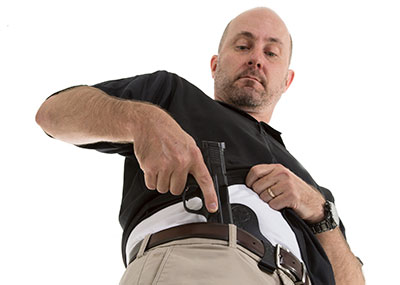
Appendix carry is nothing new although it has become a current topic among those who carry concealed. It was actually quite popular during the days of the American frontier. Contrary to what you see in movies and on television, frontiersmen did not wear their cartridge belts and holsters when they came to town. Instead, they just shoved their old sixgun into their waistband in front of their hip bone and covered it with their coat.
Appendix carry can be a viable concealed-carry technique for today's armed citizen. However, there are advantages and disadvantages to this method. And a lot of that depends upon what you are carrying and what your level of training is. Here are some of the more important factors to consider before stuffing your pistol into a holster in the front of your waistband.
One of the advantages of appendix carry is that it can provide for a very fast pistol presentation, assuming that one has practiced sufficiently. As we go about the normal tasks that make up our daily schedule, our hands tend to be located closer to the front of our body. Thus, when trouble raises its head, we have less distance to move our hands in order to acquire the defensive handgun.
In addition, a handgun carried on the front side of our body is less likely to "print" on our covering garment as we bend, stoop or otherwise move around. It works especially well when the covering garment is a t-shirt, sweatshirt or buttoned shirt that is worn with the shirttail out. With practice, one quickly learns to use the support hand to clear away the covering garment during the draw stroke.
The most serious disadvantage of appendix carry occurs when one has a negligent discharge while drawing or reholstering. When a gun is carried on the hip, or behind the hip, an ND usually only results in a relatively minor wound to the buttocks or back of the thigh. However, when that same ND occurs on the front side of the body the bullet stands a good chance of impacting the groin area or, even worse, the femoral artery. That sort of an ND is definitely life threatening.
For this reason, I only use appendix carry with certain handguns, namely revolvers. Revolvers, single action or double action, will not easily fire when your finger, or the holster, comes in contact with the trigger. I'm sure it can be done, but you'd really have to work at it and, in the case of the SA revolver, you would have to be reholstering with the hammer cocked – a move that no one in their right mind should consider.
I personally don't appendix carry with semi-autos because, in the case of the single-action auto, the safety could fail, leaving the trigger vulnerable. And, in the case of many striker-fired autos (the Glock, S&W M&P and the Springfield XD, to name a few) the safety trigger can very easily be manipulated, either by the trigger finger, the holster or shirt. This is not a condemnation of the striker-fired pistol. It is only to point out that every handgun design has its own manual of arms. And, with the striker-fired gun, you'd better be sure that nothing comes in contact with that trigger.
A person considering appendix carry should be extra certain that they use a quality holster and one that is made specifically for the gun they are carrying. In addition, they should train and practice enough so that they can be certain that they will keep the trigger finger straight at all times.
As with all things concerning personal defense with firearms, the best recipe for safe appendix carry is to get professional training. The person who simply buys a handgun and straps it on is just asking for trouble. A professional trainer can help you learn to protect yourself in a safe and efficient manner, and help you decide which defensive handgun and method of carry is best for you.
Appendix carry, in and of itself, is no more dangerous than any other carry technique when one is properly trained and armed with a handgun that lends itself to this method. It is up to each of us to be properly informed and educated.







































